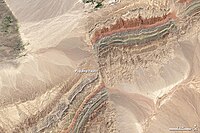
Photo from wikipedia
Abstract The deformation of overburden subjected to a reverse oblique-slip fault was examined in this study using the distinct element method, and the results were compared with the shears measured… Click to show full abstract
Abstract The deformation of overburden subjected to a reverse oblique-slip fault was examined in this study using the distinct element method, and the results were compared with the shears measured at the Nojima fault during the 1995 Hyogoken Nanbu earthquake. Shear deformation was found to occur mainly on the footwall side of the overburden in a narrow zone and to be caused by the reverse fault component. The stress due to both the reverse fault and strike-slip movement led to the development of failure surfaces with a convex-upward shape in cross section and an en echelon pattern in plan view. The width of the zones of high incremental strain obtained in the present analysis was found to be in agreement with the observed width of the shears; however, the observed and simulated intervals and orientations of the shears did not agree. The simulation results suggest that short shears that form in the deep part in the early stages of the deformation join to form longer shears as they propagate toward the surface.
Journal Title: Journal of Structural Geology
Year Published: 2017
Link to full text (if available)
Share on Social Media: Sign Up to like & get
recommendations!